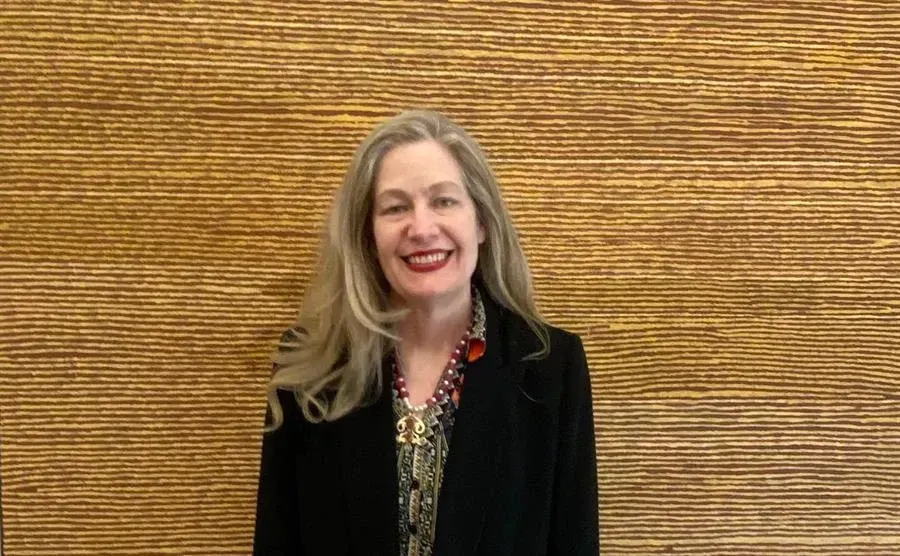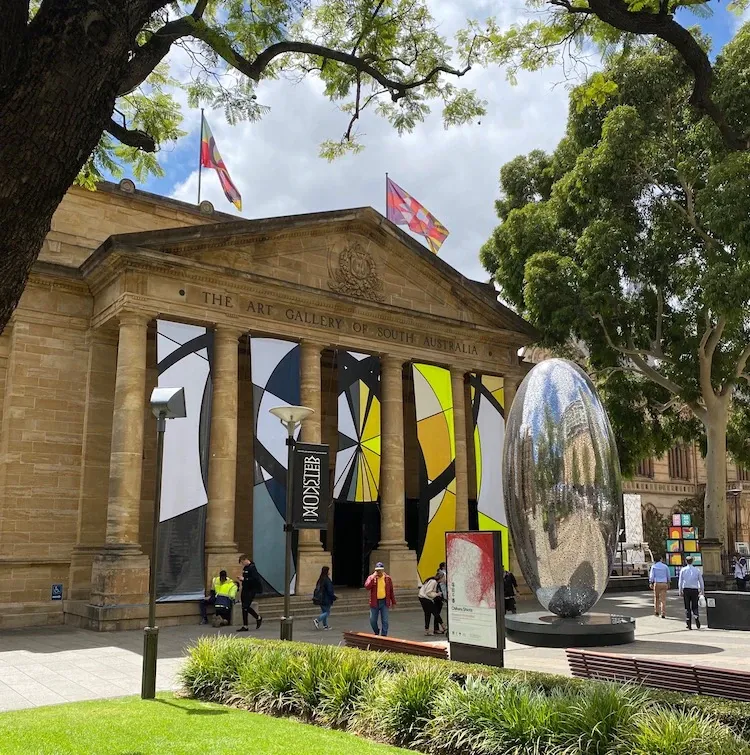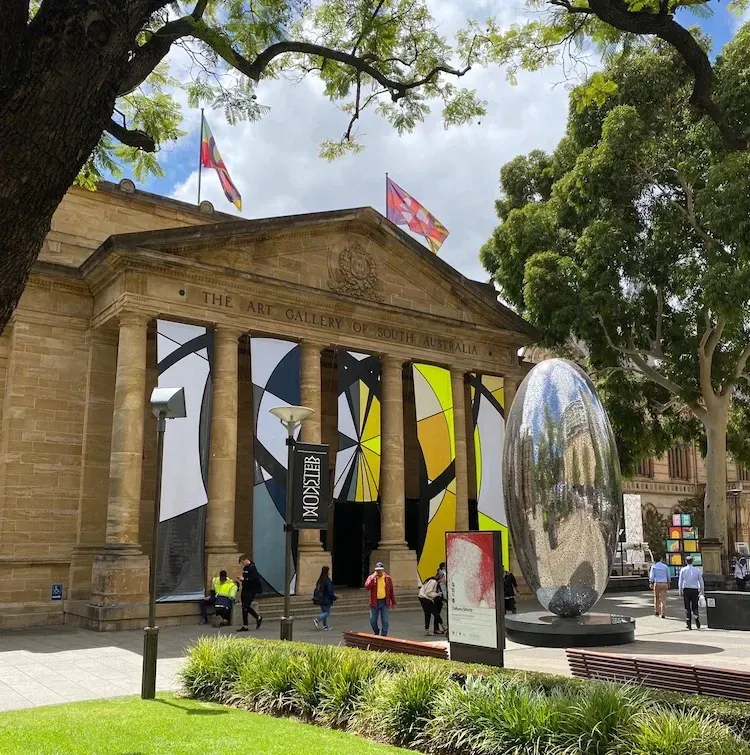Under Pressure, the Only Way is Up
Written by

The last time we last caught up with Rhana Devenport, she was just five days into the job as Director of the Art Gallery of South Australia (AGSA) – the first woman to hold the position in the Gallery’s 137-year history.
Seventeen months on since her appointment in July 2018 (starting in October) the state had a change of government, delivered a budget that had a drastic impact across the arts, embarked on a state cultural review led by Tony Grybowski and Graeme Gherashe (published July 2019), and there was a PwC (PricewaterhouseCoopers) scoping study into an Aboriginal culture centre (published Nov 2019). The state has also changed the name of the “Lot 14 Project” four times, from Adelaide Contemporary – a project that had architects in place and a vision to grow the gallery’s footprint – to most recently, the Aboriginal Arts and Culture Centre, dropping the word “gallery” entirely and pushing back the delivery date to 2023 – aka after the next election.
While that is a shopping list of belly punches that is likely to push anyone off-kilter, Devenport remains optimistic, adopting the philosophy that if you face a roadblock, then find another route.
On the eve of the Adelaide Biennial of Australia Art, a signature exhibition of the Gallery celebrating its 30th anniversary this year, Devenport old ArtsHub: ‘We're very much exhibition makers here.’
‘Our space is the smallest footprint per capita with the largest visitation – 1.3 million visitors a year – so it's that density we are talking about. We also have the third largest collection (nationally), so we are constantly asking how best to work with the collection, and keep refreshing the space for those visitors. The fact that we have such limited space, it's got to work really hard,’ Devenport continued.
Shaking things up
Her “tick list” in the job started with rolling out a new website and rehanging the Gallery’s Elder Wing with a challenging rethink of the Australian Art Collection. She delivered on the Ramsay Prize and began an important new trajectory in terms of taking Tarnanthi on tour. She has also rehung the Morris Gallery – the first time in 25 years, and she is currently developing a new project for OzAsia this year.
‘And, of course, the other major shift that's happened during that time was announced at the end of last year, with the Ramsay Bequest and with James and Diana Ramsay Fund.’ She explained the focus was about collection building in perpetuity.
Devenport was quick to credit her team. ‘You know, you give full credit where credit's due, and several of those projects were underway when I came on board. We're small enough that as Director you can be involved in everything, which suits my style.
‘The Elder rehang really was a tremendous process – a historical, trans, interstitial approach in how we've defined ourselves curatorially, and quite differently in terms of how we look at the Collection,’ she continued.
Devenport said that in some way it was a bit of a roadmap into a kind of self-determination that will shape the Gallery’s future.

The Art Gallery of South Australia, with facade work by Mikala Dwyer for the 2020 Adelaide Biennial, and sculpture by Lindy Lee. Image: ArtsHub.
With a background as both an educator and curator, programming is always at the front of Devenport’s mind, however lately she has been plagued with another vision.
‘Space, space, space! Every week there's meetings with the stakeholders, and of course we're very involved in the discussions that are shaping the Aboriginal Arts and Culture Centre, which is not initiated by the Gallery…but that doesn't take away from the needs of the Gallery here in terms of space,’ she said.
The Only Way is Up
The Gallery’s Collection is stored off-site and is at capacity. The gallery is groaning at the seams, pinned in by heritage buildings, and with attendances to openings reaching up to 6,000 – as with the annual Tarnanthi Festival – the need for additional physical space is vital.
Devenport said that she gives her full support to the government to realise its vision for the Aboriginal Arts and Culture Centre, but is steadfast in not losing sight of the Gallery’s needs also.
we need to ask what is something that's manageable and yet can offer a wonderful new space both for art and for people?
‘At the moment, we're thinking that developing the site here may be a pragmatic way to go. And, the only way to go is up.’
‘There's been such a lot of approaches and ideas that have been mooted for offsite projects, but realistically as we're entering a more constricted, restrained climate of resources, we need to ask what is something that's manageable and yet can offer a wonderful new space both for art and for people?’
She continued: ‘We don't have a design, but cantilevering is an option and respecting the site – you can't not respect history in Adelaide! So, I am thinking through how something can really meet 21st century museum needs and yet have a lightness of touch, and with engineering now it's just so exciting what's possible.
Devenport was responsible for the build of the new Len Lye Centre, as part of Govett-Brewster Art Gallery in New Plymouth
‘Not a day goes by where I am not thinking about it, but it's definitely a five year one,’ she added of her vision timeline.
In her previous roles, Devenport was responsible for the build of the new Len Lye Centre, as part of Govett-Brewster Art Gallery in New Plymouth. She is especially proud of the building she helped commission from architect Andrew Patterson.
Planning in unstable conditions
Incoming South Australian Premier Steven Marshall handed down his first budget, in which the arts sector faced a $4.9 million reduction in funds in 2018-2019, increasing annually in forward estimates to $31.9 million over four years through to 2022.
Well down the path of that fiscal journey, Devenport told ArtsHub: ‘Look, every year there's efficiency measures, and basically you go off and just repoint.’
‘It's about being responsive. Every time someone leaves, it's about re-scoping those positions. What do we really need? So there's no possibility of just an immediate reappointment. Of course you look after your staff – it's an unbelievable team and everybody works 150% – but also with every change for whatever reason, you need to really take stock,’ she said.
‘And look, the whole world is facing change. We’re not immune, and no publicly funded arts organisation is. It is having a sense of largesse about it, let's say.’ She continued: ‘Our budgets are not going to expand, so it's like, “How do you realise ambitious projects?"'
While Devenport is realistic that there may not be a lot of public funding, she believes that nothing is not impossible. ‘The philanthropic support and those relationships are critically important to the Gallery.'
Arts and Politics
Punters are saying that Premier Marshall has ‘kicked the can down the road’ for his signature commitment of a national Aboriginal Art and Cultures Centre. Last month, it was revealed that it would no longer be delivered before the 2022 election, but would open sometime in 2023.
great projects are bipartisan, they translate across different political grounds
‘The Premier has said he wants it to be built by 2023, which is really tight but it's not impossible. The main thing I'd like to say is great projects are bipartisan, they translate across different political grounds, and none of them are going to happen within three or four years,’ commented Devenport.
‘You work with both sides of government, and if it's a great project, it's endorsed by both.’
To date, $146 million has been allocated to cover the landmark project across state and city funding. ‘I think it's enough. Adelaide Contemporary wasn't much more than that. Auckland Art Gallery was only $130M. But I don't think it's going to be fast,’ Devenport said.
It's such a critically important project to get right. And it's, you know, a once in a lifetime opportunity
‘They haven't started on what the design might be, and obviously most important is consultation with the Aboriginal community. No one's more important than them in this conversation. It's such a critically important project to get right. And it's, you know, a once in a lifetime opportunity.’
Devenport noted that the project was 100% initiated by the government, adding that in her opinion, the Premier was genuine about the project, and is ‘tremendously engaged with the gallery’ and that the PwC report was broadly endorsed. ‘It's not a roadmap, and they've made that very clear, and a lot more work has to be done.’
Devenport added that another company was currently working on a new analysis.
On the Horizon
Devenport believes the greatest challenge the arts in South Australia faces is ‘its potential, and its perceived sense of isolation.’
‘I’m an evangelical for where I am – when you’re looking at the map of Australia, Adelaide sits at its centre, so we're the fulcrum. We're not far from anywhere, and it does allow a different perspective,’ she said.
She believes that slight separation allows for a freshness of approach and immediacy. ‘I think it allows a connection from idea to actuality – a tremendous cohesion. It’s a city that works together very well.’
Devenport said that the Gallery’s program is structured around recurring programs – the Ramsay Prize, which is funded in perpetuity; Tarnanthi which is dependent on BHP funding (committed until 2021); and the Adelaide Biennial, funded through a mix of public and private money.
'I think that regularity, it absolutely underscores the importance of those perennial exhibitions, but again it means there's very little space for other kinds of exhibitions. We want to set up a winter offering, and that is what the exhibition Phenomena is about. Everyone does it; it's nothing new, but it's something to really focus attention for our audiences to expect something possibly international and something out of the ordinary, because all of those three projects we deliver are Australian and we make from scratch,' she said.
‘It's high octane because of that, but then how do you counterbalance that with the right kind of international or major exhibitions or partnership exhibitions,’ she added. ‘And you need that because in terms of the South Australian audience, they need to have a sense of validation within the global conversation.’
Devenport and her team are currently working on options, soon to be announced.
By Gina Fairley, originally published by our friends at Artshub Australia.
